Millet Bread
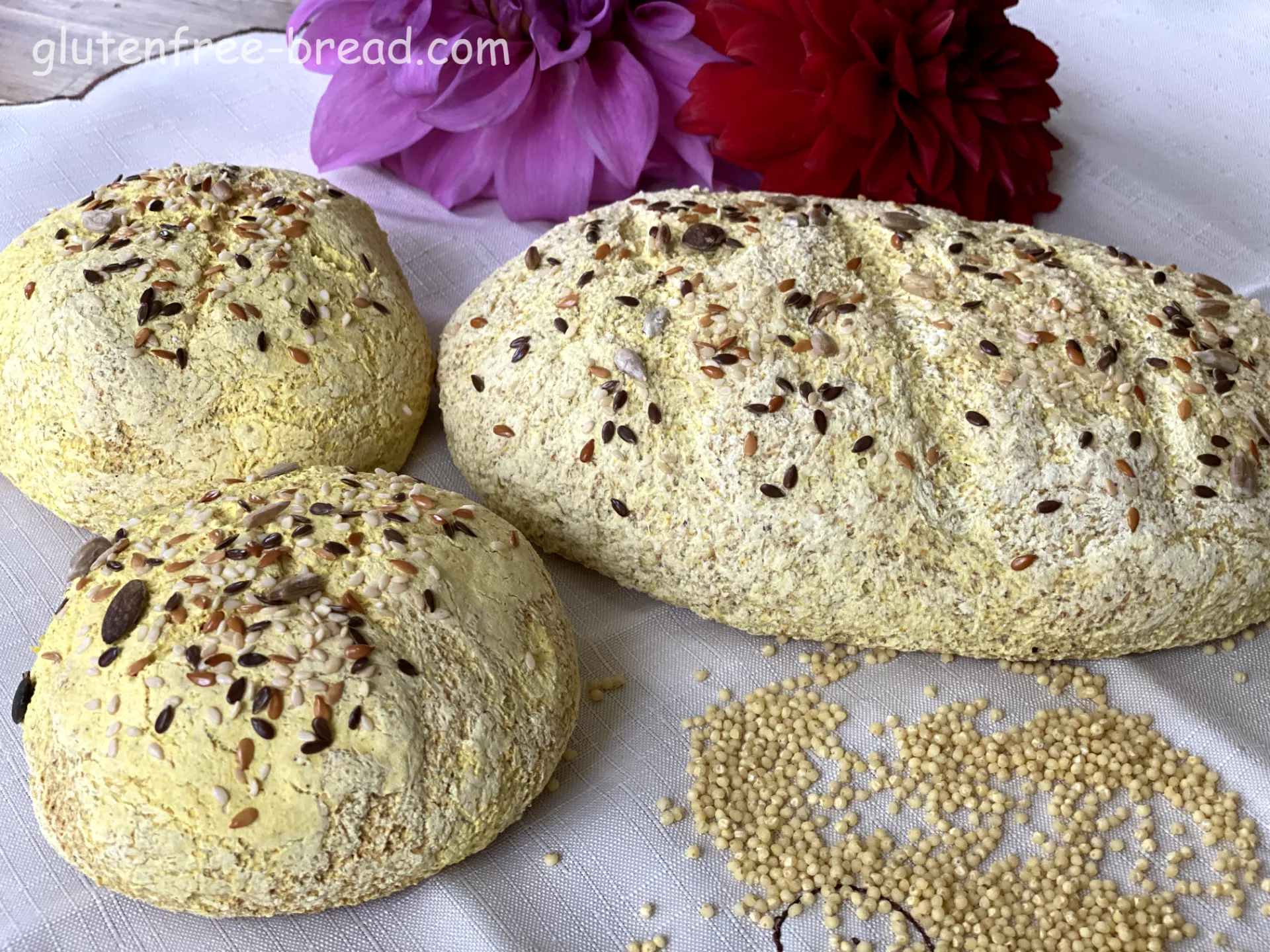
Gluten Free, Low Carbs, Sugar Free, Dairy Free, Yeast Free, Egg Free, Vegan, Nut Free
Ingredients:
| Name | Metric | US | TIP | |
|---|---|---|---|---|
| Millet, dry | 150 gr | 3/4 cup | ||
| Water, up to | 330 gr | |||
| Whole Psyllium Husks | 11 gr | 2 tablespoons | ||
| Baking Powder | 7 gr | 1 tsp | ||
| Olive Oil | 15 ml | 1 tablespoon | ||
| Salt | 6 gr | 1 teaspoon |
Optional Ingredients:
| 6 gr / 1 tsp Toasted Sesame Seeds | |
| 6 gr / 1 tsp Turmeric, for color |
Equipment:
| Blender | |
| Loaf pan 8.5in x 4.5 inch / 21.5cm x 11.5cm |
Steps:
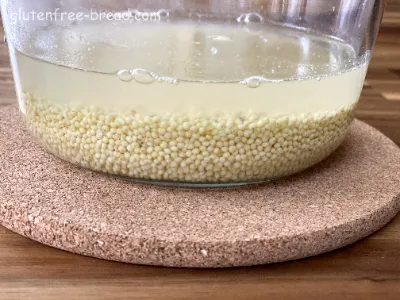
Rinse the dry Millet (150 g) under cold water. Soak it in water for 8 hours or overnight. Rinse the dry Millet (150 g) under cold water. Soak it in water for 8 hours or overnight.
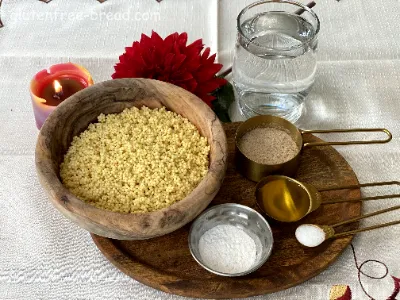
Preheat the oven to 395°F ( 200°C ) and line the loaf pan with parchment paper. Preheat the oven to 395°F ( 200°C ) and line the loaf pan with parchment paper.

After soaking, drain the millet thoroughly. After soaking, drain the millet thoroughly.
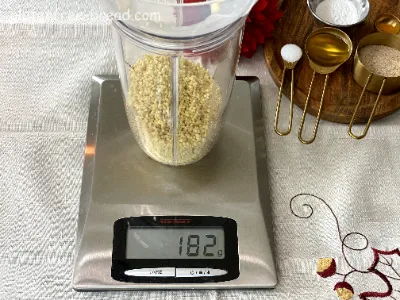
Weigh it to determine the amount of water it has absorbed. Weigh it to determine the amount of water it has absorbed.
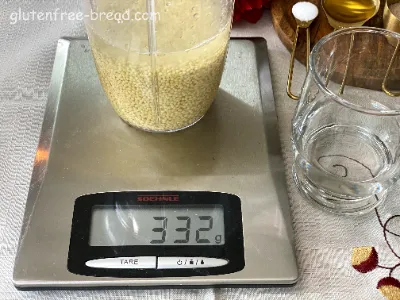
Add enough Water to the drained Millet until the total mixture weighs 330 grams. Add enough Water to the drained Millet until the total mixture weighs 330 grams.
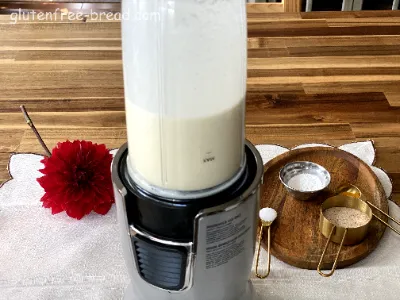
Stir in the Olive Oil (15 ml ), Salt, and any additional spices to taste. Transfer the mixture to a blender and blend until smooth. Stir in the Olive Oil (15 ml ), Salt, and any additional spices to taste. Transfer the mixture to a blender and blend until smooth.
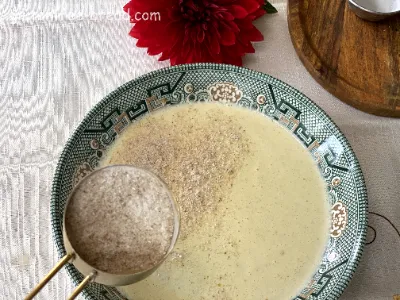
In a separate bowl, mix 7 gr of Baking Powder and 11 gr of Whole Psyllium Husks into the blended millet mixture. Stir well until fully combined. Let the mixture sit for about 5 minutes to thicken. In a separate bowl, mix 7 gr of Baking Powder and 11 gr of Whole Psyllium Husks into the blended millet mixture. Stir well until fully combined. Let the mixture sit for about 5 minutes to thicken.
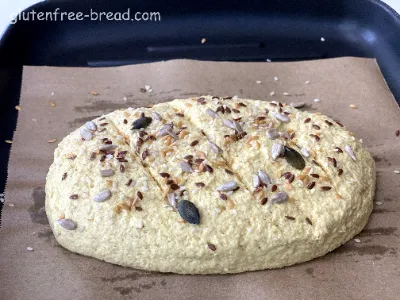
Transfer the mixture to a prepared loaf pan or baking tray. Smooth the top with a spatula and sprinkle with seeds if desired. Transfer the mixture to a prepared loaf pan or baking tray. Smooth the top with a spatula and sprinkle with seeds if desired.

Place the pan in the preheated oven and bake for approximately 45 minutes. Baking times may vary, so check towards the end of the suggested time. Perform a tap test or skewer test to ensure the bread is fully cooked. Place the pan in the preheated oven and bake for approximately 45 minutes. Baking times may vary, so check towards the end of the suggested time. Perform a tap test or skewer test to ensure the bread is fully cooked.
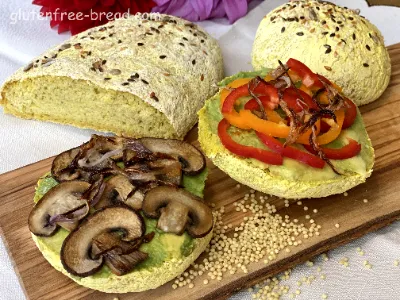
Allow the bread to cool completely on a wire rack. Once cooled, slice and enjoy your freshly baked Millet Bread! Allow the bread to cool completely on a wire rack. Once cooled, slice and enjoy your freshly baked Millet Bread!
Comments:
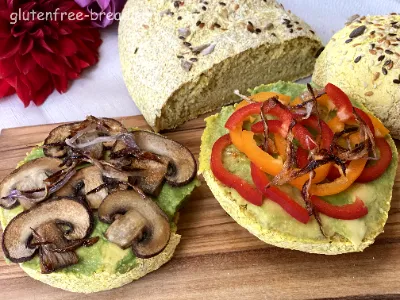
Millet Bread
Millet is a naturally gluten-free grain renowned for its rich nutritional profile. It is packed with essential nutrients such as calcium, iron, potassium, magnesium, phosphorus, and zinc. Millet also provides dietary fiber, protein, and a range of bioactive compounds including polyphenols, B vitamins, niacin, folic acid, flavonoids, and proanthocyanidins.
One important component of millet is phytic acid, which possesses antioxidant properties. However, in large quantities, phytic acid can act as an anti-nutrient. It binds primarily to key minerals like calcium, iron, potassium, magnesium, and phosphorus, inhibiting their absorption in the small intestine.
To maximize the nutritional benefits of millet and enhance its digestibility, proper preparation is essential. Soaking millet for at least 8 hours before cooking is highly recommended. This process allows phytic acid and other anti-nutrients to dissolve into the soaking water, as they are water-soluble. Additionally, soaking activates enzymes in millet that further improve digestion and nutrient absorption.
By following these preparation steps, you can make the most of millet’s nutritional benefits and enjoy its wholesome goodness in your meals.
Millet Bread additional information:
Health Benefits and Nutritional Value
Gluten-Free:
- Millet is naturally gluten-free, making this bread an excellent choice for individuals with celiac disease or gluten sensitivity.
High in Essential Nutrients:
- Millet is rich in essential nutrients such as calcium, iron, magnesium, phosphorus, and potassium, contributing to overall health and wellness.
Rich in Antioxidants:
- The presence of antioxidants in millet, including flavonoids and polyphenols, helps combat oxidative stress and may reduce the risk of chronic diseases.
Supports Digestive Health:
- Millet’s fiber content supports healthy digestion by promoting regular bowel movements and preventing constipation.
Nutrient Absorption:
- Proper preparation of millet reduces phytic acid, enhancing the absorption of essential minerals.
Texture and Flavor
Unique Texture:
- Millet bread has a distinctive, slightly nutty flavor and a tender crumb. Its texture is often described as light and airy, thanks to the blending and baking process.
Versatility:
- This bread pairs well with a variety of spreads, from savory options like avocado or hummus to sweet choices such as honey or fruit preserves.
Preparation and Cooking Tips
Blending for Smoothness:
- Blending the soaked millet until smooth helps achieve a consistent texture in the bread, contributing to its light and airy quality.
Baking Variations:
- You can experiment with adding seeds, nuts, or dried fruits to the bread for extra flavor and nutritional benefits.
Cooling Properly:
- Allow the bread to cool completely on a wire rack before slicing. This helps maintain its structure and prevents it from becoming soggy.
Serving Suggestions
Meal Pairings:
- Serve millet bread with soups, salads, or as a side with main courses. It also makes a great base for sandwiches or toast.
Storage Tips:
- Store leftover bread in an airtight container at room temperature for up to 3-4 days. For longer storage, you can freeze it in slices and toast as needed.
Sustainability
- Environmentally Friendly:
- Millet is a hardy crop that requires less water and can be grown in various climates, making it a more sustainable choice compared to some other grains.
By highlighting these aspects, you can provide a comprehensive view of millet bread, from its health benefits and unique qualities to practical tips for preparation and serving.
